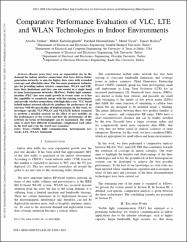| dc.contributor.author | Zeshan, Arooba | en_US |
| dc.contributor.author | Karbalayghareh, Mehdi | en_US |
| dc.contributor.author | Miramirkhani, Farshad | en_US |
| dc.contributor.author | Uysal, Murat | en_US |
| dc.contributor.author | Baykaş, Tunçer | en_US |
| dc.date.accessioned | 2021-11-09T17:54:41Z | |
| dc.date.available | 2021-11-09T17:54:41Z | |
| dc.date.issued | 2021-05-24 | |
| dc.identifier.citation | Zeshan, A., Karbalayghareh, M., Miramirkhani, F., Uysal, M. & Baykaş, T. (2021). Comparative performance evaluation of VLC, LTE and WLAN technologies in indoor environments. Paper presented at the 2021 IEEE International Black Sea Conference on Communications and Networking (BlackSeaCom), 119-124. doi:10.1109/BlackSeaCom52164.2021.9527770 | en_US |
| dc.identifier.isbn | 9781665403085 | |
| dc.identifier.isbn | 9781665430982 | |
| dc.identifier.issn | 2375-8236 | |
| dc.identifier.uri | https://hdl.handle.net/11729/3284 | |
| dc.identifier.uri | http://dx.doi.org/10.1109/BlackSeaCom52164.2021.9527770 | |
| dc.description.abstract | Recent years have seen an exponential rise in the demand for indoor wireless connections that have driven future generation networks to aim for higher data rates with extended coverage and affordable rates. The two most prominent technologies for providing indoor wireless connections, WLAN and LTE, have their limitations and they can not coexist in a single band to form heterogeneous networks (HetNets). Visible light communication (VLC) has seen rapid growth in recent years as it has the capability to seamlessly merge with the existing technologies and provide wireless connections with high data rates. VLC based hybrid indoor network effectively combines the preferences of an end-user with the practicality of implementation. In this work, we investigate specific VLC/WLAN and VLC/LTE hybrid scenarios to perform a detailed analysis on the effect of user mobility on the performance of the system and how the performance of the network (in terms of throughput) can be maximized. The study aims to show how different technologies complement each other in the best and even the worst-case scenarios. | en_US |
| dc.language.iso | eng | en_US |
| dc.publisher | IEEE | en_US |
| dc.relation.isversionof | 10.1109/BlackSeaCom52164.2021.9527770 | |
| dc.rights | info:eu-repo/semantics/closedAccess | en_US |
| dc.subject | Comparative performance | en_US |
| dc.subject | Femtocells | en_US |
| dc.subject | Future generations | en_US |
| dc.subject | Heterogeneous network (HetNets) | en_US |
| dc.subject | Heterogenous networks | en_US |
| dc.subject | Indoor environment | en_US |
| dc.subject | Indoor networks | en_US |
| dc.subject | LTE | en_US |
| dc.subject | Visible light communication | en_US |
| dc.subject | Visible light communications (VLC) | en_US |
| dc.subject | Visible light communication | en_US |
| dc.subject | Wireless connection | en_US |
| dc.subject | Wireless local area networks (WLAN) | en_US |
| dc.subject | WLAN | en_US |
| dc.subject | Worst case scenario | en_US |
| dc.subject | Coexistence | en_US |
| dc.subject | Prediction | en_US |
| dc.subject | Wifi | en_US |
| dc.subject | MHZ | en_US |
| dc.title | Comparative performance evaluation of VLC, LTE and WLAN technologies in indoor environments | en_US |
| dc.type | conferenceObject | en_US |
| dc.description.version | Publisher's Version | en_US |
| dc.relation.journal | 2021 IEEE International Black Sea Conference on Communications and Networking (BlackSeaCom) | en_US |
| dc.contributor.department | Işık Üniversitesi, Mühendislik Fakültesi, Elektrik-Elektronik Mühendisliği Bölümü | en_US |
| dc.contributor.department | Işık University, Faculty of Engineering, Department of Electrical-Electronics Engineering | en_US |
| dc.contributor.authorID | 0000-0002-6691-9779 | |
| dc.identifier.startpage | 119 | |
| dc.identifier.endpage | 124 | |
| dc.peerreviewed | Yes | en_US |
| dc.publicationstatus | Published | en_US |
| dc.relation.publicationcategory | Konferans Öğesi - Uluslararası - Kurum Öğretim Elemanı | en_US |
| dc.contributor.institutionauthor | Miramirkhani, Farshad | en_US |
| dc.relation.index | WOS | en_US |
| dc.relation.index | Scopus | en_US |
| dc.relation.index | Conference Proceedings Citation Index – Science (CPCI-S) | en_US |
| dc.description.wosid | WOS:000892556200021 | |



















